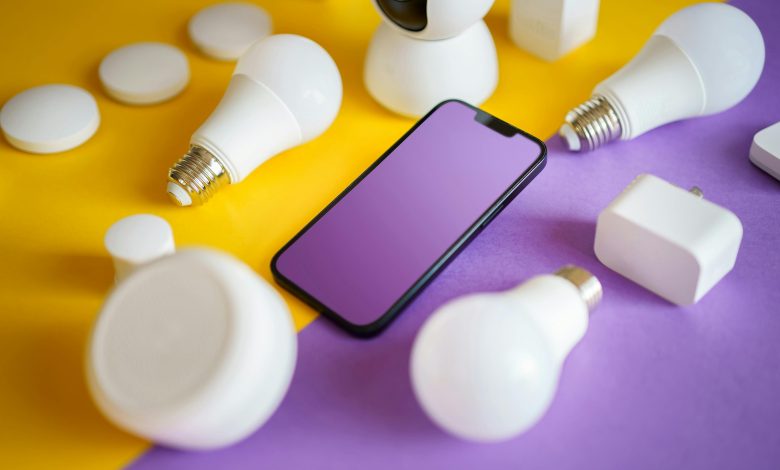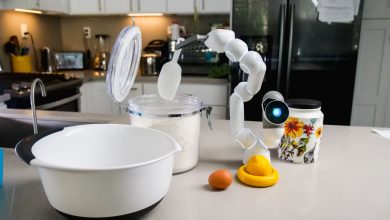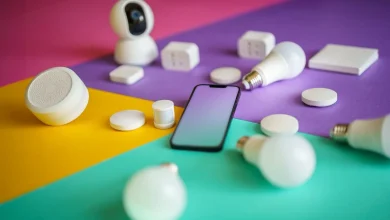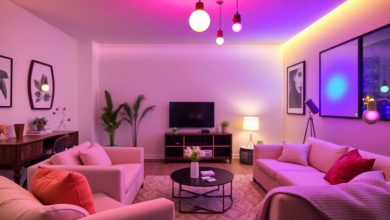Smart Lighting Trends for 2025: Energy Efficiency and Mood Control in Your Home

As we step into 2025, the world of smart lighting is evolving rapidly. With a focus on energy efficiency and mood enhancement, these new technologies are transforming how we illuminate our homes. The trends are all about convenience and sustainability, from smart LED lighting systems that adapt to our needs to innovative solutions like voice-controlled lighting. Let’s explore the exciting developments shaping the future of smart lighting trends for 2025 and home lighting.
Table of Contents
Key Takeaways
- Smart light strips allow you to easily adjust brightness and colors using apps or voice commands.
- Energy-efficient smart bulbs help reduce electricity consumption, making them a sustainable choice for modern homes.
- These lighting systems can create different moods, whether you’re hosting a party or winding down for the night.
- Integration with home automation systems makes managing your lighting more convenient and intuitive.
- Trends in 2025 focus on eco-friendly features, like using solar energy and recyclable materials in lighting designs.
Innovative Smart Lighting Solutions
Smart lighting is really taking off, and it’s not just about turning lights on and off with your phone anymore. We’re seeing some seriously cool stuff that’s changing how we think about lighting our homes. It’s all about making things more convenient, efficient, and, let’s be honest, way more fun.
Smart Light Strips for Customization
Smart light strips are a game-changer. They let you add light anywhere, and I mean anywhere. Under cabinets, behind TVs, along ceilings – you name it. You can change the colors to match your mood, the time of year, or even just because you feel like it. Plus, many of them can sync with music, which is pretty awesome for parties. They’re energy-efficient too, so you don’t have to feel guilty about having them on all the time. Adaptive lighting is also becoming more common, adjusting brightness based on your activities. For example, they brighten when you enter a room or dim when you leave. This feature not only saves energy but also creates a more intuitive lighting experience.
Voice-Controlled Lighting Systems
“Hey Google, turn on the living room lights!” It’s getting easier and easier to control your lights with just your voice. These systems work with smart assistants like Alexa and Google Assistant, so you can adjust brightness, change colors, and even set scenes without lifting a finger. It’s super convenient, especially when your hands are full or you’re just feeling lazy. Plus, you can integrate them with other smart home devices for even more automation.
Integration with Home Automation
Smart lighting is becoming a key part of the whole smart home ecosystem. You can connect your lights to other devices like thermostats, security cameras, and even your coffee maker. Imagine your lights automatically dimming when you start a movie, or turning on when your security camera detects motion outside. It’s all about creating a seamless and automated living experience. This level of integration not only enhances convenience but also boosts home security and energy efficiency. For example, you can program your lights to turn on when your smart doorbell detects motion, enhancing both convenience and security.
Smart home integration is really about making your life easier and more comfortable. It’s about creating a home that responds to your needs and anticipates your desires. And smart lighting is a big part of that.
Energy Efficiency in Home Lighting
Benefits of Energy-Efficient Smart Bulbs
Okay, so, energy-efficient smart bulbs? They’re kind of a big deal. I mean, who doesn’t want to save money on their electricity bill? Switching to LEDs is probably the easiest way to do that. They use way less power than those old incandescent bulbs my grandma still has. Plus, they last way longer, so you’re not constantly replacing them. It’s a win-win. You can save a lot of money by switching to energy-efficient LED technology.
- Lower energy bills
- Longer lifespan
- Reduced maintenance
Adaptive Brightness Features
Adaptive brightness is pretty cool. Basically, the lights adjust themselves depending on how much natural light is in the room. So, if it’s a sunny day, they dim down, and if it’s cloudy, they brighten up. It’s all automatic, so you don’t even have to think about it. Smart light strips also have this feature. It’s not just about saving energy, though. It also makes the lighting more comfortable for your eyes. No more squinting at your screen because the lights are too bright.
Sustainable Lighting Practices
Thinking about the environment is important, and lighting is a good place to start. There are a bunch of things you can do to make your lighting more sustainable. Using those energy-efficient bulbs is a big one, of course. But you can also think about things like using timers and motion sensors to make sure lights aren’t on when they don’t need to be. And when it’s time to replace your fixtures, look for ones made from recycled materials.
It’s not just about saving money; it’s about doing your part to protect the planet. Every little bit helps, and making smart choices about your lighting can make a real difference.
Mood Control Through Lighting
Lighting isn’t just about seeing; it’s about feeling. Smart lighting takes this to a whole new level, letting you craft the perfect atmosphere for any moment. Forget harsh, generic overhead lights – we’re talking about personalized ambiance at your fingertips.
Circadian Rhythm Lighting
Imagine lights that adjust automatically throughout the day, mimicking the sun’s natural cycle. That’s the power of circadian rhythm lighting. These systems shift from cool, energizing tones in the morning to warm, relaxing hues in the evening, supporting your body’s natural sleep-wake cycle. It’s like having a personal sunrise and sunset indoors, promoting better sleep and overall well-being. It’s a game changer for those of us who spend a lot of time indoors.
Dynamic Color Changing Options
Want to transform your living room into a cozy haven or a vibrant party space? Dynamic color changing options make it easy. With RGB LED lights, you can select from a spectrum of colors to match your mood or the occasion. Some systems even let you create custom color palettes and lighting effects. It’s all about expressing your personal style and creating the perfect vibe.
By 2025, smart lighting will transform homes with AI-driven efficiency and mood-enhancing hues. Motion-responsive systems slash energy use while adapting colors to boost focus or calm. Explore Smart Lighting Trends 2025—where tech meets tranquility.
Personalized Ambiance Settings
Smart lighting systems often come with pre-set ambiance settings for different activities, like reading, watching movies, or entertaining guests. But the real magic happens when you start creating your own personalized settings. You can adjust the brightness, color temperature, and even the direction of the light to achieve the perfect ambiance for any situation. Plus, with smartphone control, you can manage your app control LED from anywhere.
Technological Advancements in Smart Lighting
IoT Integration for Smart Homes
Smart lighting is getting even smarter with better IoT integration. This means your lights can now talk to almost everything else in your house. Imagine your lights dimming automatically when your TV turns on, or changing color when your security system detects something. It’s all about making your home work together.
- Seamless connectivity with other smart devices
- Centralized control through a single app
- Automated responses to environmental changes
The goal is to create a truly connected home experience, where lighting adapts to your needs without you even having to think about it.
Li-Fi Technology in Lighting
Li-Fi is a really interesting development. Instead of using radio waves like Wi-Fi, it uses light to transmit data. This could mean super-fast internet speeds through your light bulbs. It’s still pretty new, but the potential is huge.
- Faster data transmission compared to traditional Wi-Fi
- More secure connections, as light can’t pass through walls
- Potential for use in areas where radio waves are restricted
Advanced Power Management Systems
We’re also seeing improvements in how smart lights use power. New systems are designed to be incredibly efficient, saving you money on your electricity bill. They can even learn your habits and adjust their power usage accordingly.
- Real-time energy monitoring and reporting
- Predictive algorithms to optimize power consumption
- Integration with renewable energy sources for even greater savings
Practical Applications of Smart Lighting
Accent Lighting for Aesthetics
Smart lighting isn’t just about function; it’s about style. Accent lighting can dramatically change the feel of a room. I’ve seen people use it to highlight artwork, architectural details, or even just to add a pop of color to a dull corner. It’s amazing how a little light can make such a big difference. Think about using it under cabinets, behind TVs, or along hallways to create a more inviting space. It’s a simple way to make your home feel more luxurious and personalized. Smart light strips are great for residential lighting trends 2025.
Integration with Virtual Assistants
Okay, so I’m not the most tech-savvy person, but even I can appreciate how easy it is to control my lights with my voice. I mean, who wants to get up to flip a switch when you can just tell Alexa to do it? It’s especially useful when my hands are full or when I’m already tucked into bed. Plus, you can set up routines so the lights automatically adjust at certain times of the day. It’s like having a personal lighting assistant! Here’s a few things you can do:
- Turn lights on/off
- Dim or brighten lights
- Change colors
- Set schedules
I recently set up a routine where my lights gradually brighten in the morning to mimic a sunrise. It’s a much gentler way to wake up than a blaring alarm clock, and it actually makes me feel more energized throughout the day.
Compact Designs for Versatile Use
Smart lighting isn’t just about big, fancy fixtures. There are tons of compact and discreet options available now that can fit into any space. Think about tiny LED spotlights for highlighting specific objects, or thin light strips that can be hidden under shelves or cabinets. The possibilities are endless! Smart outdoor lighting offers compelling advantages over traditional exterior illumination. These smaller designs are perfect for adding a touch of light without overwhelming a room, and they’re great for renters who can’t make permanent changes to their space.
Trends Shaping the Future of Lighting
Human-Centric Lighting Approaches
Human-centric lighting is really taking off. It’s all about designing lighting systems that benefit our health and well-being. I’ve been reading up on how it can improve sleep and boost mood. It’s not just about brightness; it’s about the color temperature and timing of light exposure.
- Mimicking natural daylight patterns to regulate circadian rhythms.
- Adjusting light intensity and color based on time of day.
- Reducing blue light exposure in the evening to promote better sleep.
I think the shift towards human-centric lighting is a game-changer. It’s not just about seeing better; it’s about feeling better. It’s a move away from just illuminating a space to actually caring about how that light affects the people in it.
Minimalist and Invisible Light Sources
I’m seeing a big trend towards minimalist lighting. Think sleek, almost invisible fixtures that blend seamlessly into the architecture. It’s all about creating a clean, uncluttered look. Lighting design is evolving, and I’m here for it.
- Integrated LED strips hidden within walls or ceilings.
- Recessed lighting with minimal trim.
- Focus on indirect lighting to create a soft, ambient glow.
Energy-Efficient OLED Systems
OLED lighting is becoming more popular, and for good reason. OLEDs are incredibly energy-efficient and offer a beautiful, diffuse light. Plus, they’re thin and flexible, which opens up a lot of design possibilities. I’m excited to see how OLEDs will be used in the future.
- Lower energy consumption compared to traditional LEDs.
- Uniform light distribution without harsh shadows.
- Potential for flexible and transparent lighting applications.
Wrapping It Up: The Future of Smart Lighting
As we move towards 2025, smart lighting is set to change how we experience our homes. With features that let you adjust brightness and colors with just your voice or a tap on your phone, it’s all about making life easier and more enjoyable. These lights not only save energy but also help create the perfect mood for any occasion. Whether you want a cozy atmosphere for a quiet night in or vibrant colors for a party, smart lighting has got you covered. Plus, with a focus on sustainability, these innovations are good for both your home and the planet. So, get ready to embrace a brighter, more efficient future in your living spaces!
Frequently Asked Questions
What are smart light strips?
Smart light strips are flexible LED lights that you can control with your phone or voice. They let you change colors and brightness to create different moods in your space.
How do smart light strips help save energy?
These strips use energy-efficient LED technology, which uses less electricity. Some can also adjust their brightness based on how much natural light is in the room.
Can I use smart light strips for mood lighting?
Yes! Smart light strips can change colors and brightness to match your mood or the event, whether it’s a cozy night in or a lively party.
How do smart lights work with home assistants?
Smart light strips can connect to home assistants like Alexa or Google Assistant. This means you can control your lights with simple voice commands.
Are smart light strips environmentally friendly?
Yes, many smart light strips are designed with eco-friendly features, like using less energy and being made from recyclable materials.
What are some popular uses for smart light strips?
People use smart light strips for accent lighting in living rooms, under cabinets, or even outdoors. They can highlight features in your home or create a fun atmosphere.


